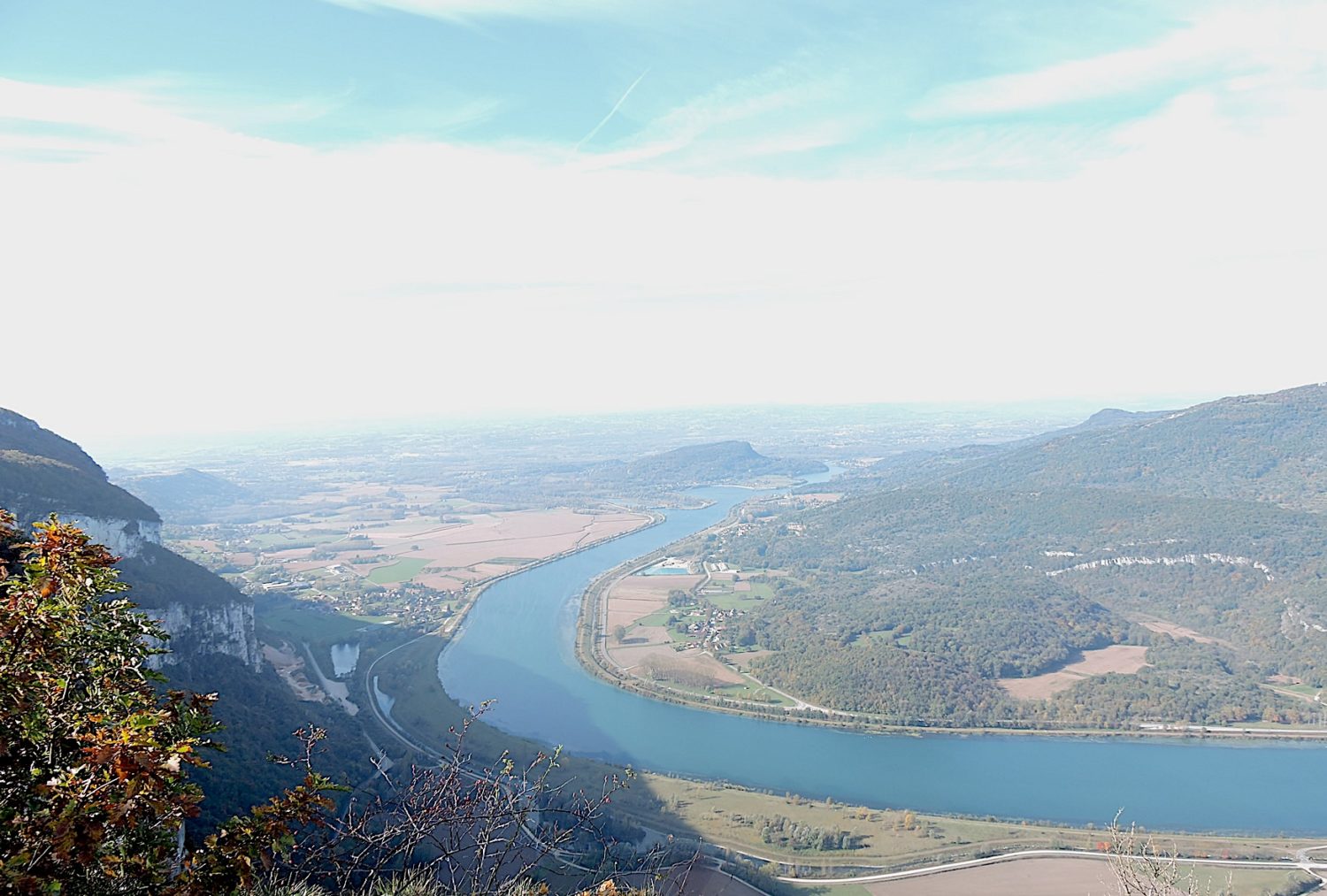The Puy, capital of Velay, with its 20’000 inhabitants. Very famous for the pilgrimage to the Black Madonna, it is in every way charming, under its roofs of red tiles, sometimes orange. Old buildings, often impassive and massive, sit along the cobbled streets, often tortuous. In the old town, the stores are full of lace, verbena and green lentils. The rue des Tables, with its stairs on the top, is the heart of the old town.
|
Let’s take a quick tour of the old town. You understand immediately that you must have faith to climb the steps of the beautiful Rue des Tables heading to the Cathedral. |
|
 |
 |
|
Here, they respected the religiosity of the place, and they did not sell the street to the merchants, as in large tourist places. The shops, and they are few, are quartered at the bottom of the street, on a square. You can even buy here the equipment to start the Way to Santiago. |
|
 |
 |
The original cathedral was erected in the XIIth century, in Romanesque style. The Byzantine influence is evident in its domes, colours and mosaics. The stones are polychrome volcanic stones, the same ones that you find in abundance in the old houses of the region. The church was first built on the rock, but due to the influx of pilgrims, additional parts erected on the void were added. But there! You will have the feeling of being in front of a building of origin. It is not so. The building nearly fell into ruins in the early XIXth century. From 1844 to 1870, the building was almost completely demolished and rebuilt, stone by stone, almost identical. One can only emphasize the art and the care with which this restoration took place.
Once at the top of the wide and long stone staircase of 134 steps, you are in front of the porch. The west facade of the cathedral has five floors, with alternating arches and many mosaics. If you travelled to Vezelay, France, or Aachen, Germany, you will quickly see the similarity of this type of architecture, with opposite colours. If you are a fan of Byzantine architecture, you will also find a family look with the Cordoba Mosque in Spain. Of course, here, the stones of different colours were all on the spot. Be that as it may, here it’s pure Romanesque style.

|
The building is of a huge complexity. In addition to the church are other buildings, including the cloister, the Chapel of Penitents and the Baptistery St John. Here, the visit of the church is free. It is a real obstacle course, a route marked for the visit. You cannot enter the nave of the church by the grand staircase, but above by additional corridors and stairs to reach the big nave. |
|
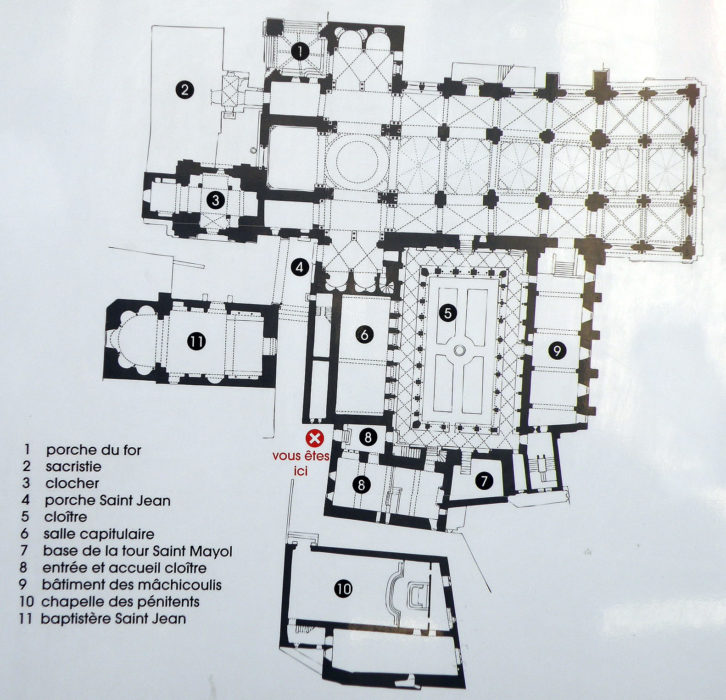 |
 |
| http://lespassions.fr/le-puy-plan-de-la-cathedrale-44 | https://fr.wikipedia.org/wiki/Cathédrale_Notre-Dame-de-l’Annonciation_du_Puy-en-Velay | ||
|
The church has a Latin cross shape and includes a 6-bay nave with additional bays, numerous apses. You have to come here with an expert, because the structure is complex, especially since, as there was no more space on the rock, the architects built part of the church in the void, to support the new spans. The vaults support beautiful domes. It is in the background, near the altar, that the Black Madonna stands. |
|
 |
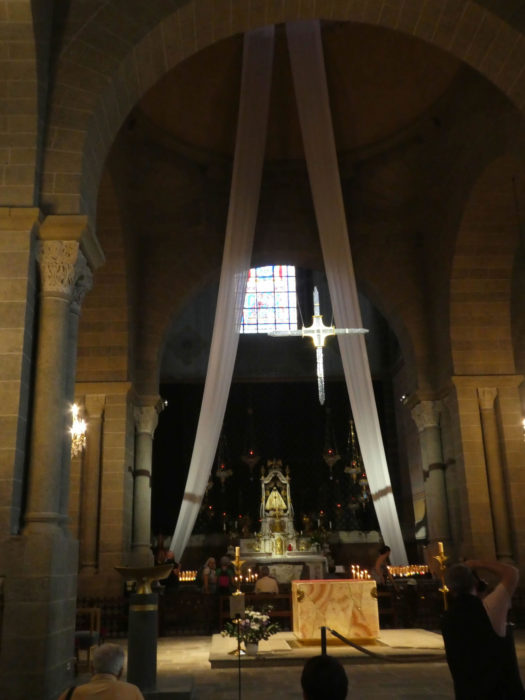 |
The statue of the Black Madonna has a long history. Mentioned in the XIth century, it has always been the attribute of great veneration on the part of pilgrims, before being destroyed during the Revolution. But we must go back even further in time, in legends. There must have been a dolmen here that occupied the current location of the cathedral. There remains a trace, a part of the stone preserved in a chapel under the name of Pierre des Fièvres (Stone of Fevers) or Pierre des Apparitions (stone of Apparitions). It is on this dolmen that would have appeared in the IIIth century the Virgin to a lady of Puy suffering from a great fever, promising healing as long as she spread on the stone. What she did. The brave lady made steps to the local bishop to set up an oratory in this place. After several other healings they decided to build a church. This original rock where the dolmen was located is the Rocher Corneille. The word Corneille may have originated from a deer, Cernunnos, Gallic god, the site being an old memory of the worship of this deity. The Marian sanctuary quickly becomes the seat of a pilgrimage. If the origin of the cult of Our Lady of the Annunciation is in the Stone of Fevers, the Middle Ages and modern times especially worship the Black Madonna.
The Marian cult culminates in the XIIIth century. The city is hence denominated Puy-Sainte-Marie or Puy-Notre-Dame. Pilgrims and potentates flock from all horizons, and jubilees follow one another in holy years. These great feasts take place each time Good Friday, the day of Christ’s death, coincides with March 25, the day of the Annunciation. There were even dead people, trapped by crowds of people here. Today, August 15, Assumption Day, the statue of the Virgin Mary is solemnly carried in the streets during the processions.
The current black virgin, at the end of the apse of the cathedral, near the high altar, replaces since 1856 the medieval statue which was burned during the Revolution. It is a copy of a XVIIth century statue. It is clad in a mantle whose color changes according to the liturgical times. The previous statue of old times was made of cedar wood, probably containing relics, with clothes painted directly on the wood. But, nobody really knows the origin of the blackening of the face of the Virgin, whose origin is traced back to the XVth century.

|
You’ll leave the church by a back door towards the Porch of the For. The porch, overlooking the square of the same name, above the roofs of the old town, dates from the late XIIth century. It is of Romanesque style, but with later additions. The first floor contains a XVth century chapel. Two doors open on this porch. The smallest is the papal door, is reserved for the pontiff, but used by fellow builders of cathedrals to enter the monument. The other, the big one, the one that stands out, is Romanesque. |
|
 |
 |
|
The marked route avoids the body of the building, passes under the tower from where you can see the stacking of floors. Everything here is bathed in dark volcanic stones. |
|
 |
 |
|
The route passes near the Baptistery of St John. This magnificent building was built at the end of the V-VI centuries, on ancient Roman sanctuary. There was much discussion and work among the experts to change the structures a little, the baptisteries often having similar structures in Europe. We know that during the XIth century, there were sculptures and paintings. Then, the monument was embellished and restored in the XXth century. This monument is quite exceptional, full of religiosity and fervor. |
|
 |
 |
|
The cloister is next door. This magnificent cloister, one of the most beautiful cloisters in the world, dates from the XIIth century, in Romanesque style. It was restored by Viollet-le-Duc in the late XIXth century. Having not been able to visit it, we can only have recourse to the Internet to show you its beauty. Here volcanic stones burst in the middle of the white sandstone. Some would say that it’s like the mosque in Cordoba, Spain. But, this type of « Byzantine » architecture precedes that put in place by the Muslims. Paleochristian lovers of the time of Charlemagne will be able to visit the Palatine Chapel of Aix-la-Chapelle to be convinced. Next door, at the Chapel of the Penitents, we found a closed door. |
|
 |
 |
| https://fr.wikipedia.org/wiki/Fichier:Le_Puy-en-Velay. Auteur : Jean-Pol GRANDMONT, Wikipedia Commons | |||
|
This is where the queue of tourists who climbs on Mount Anis begins to say hello to Notre-Dame-de France. In fact, Mount Anis, Rocher de Corneille, it’s a bit the same story. A Gallo-Roman temple was present here at the city of Anis, the former name of Puy-en-Velay, on the site of the cathedral. Up on the rock, in fact the rock Corneille, the Romans had built a veritable acropolis. The temple was dedicated to Diana and was to house the dolmen that later became the Pierre des Fièvres. |
|
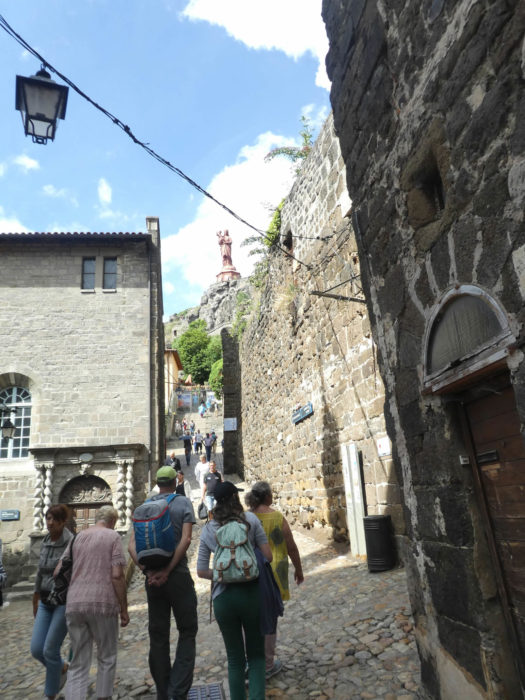 |
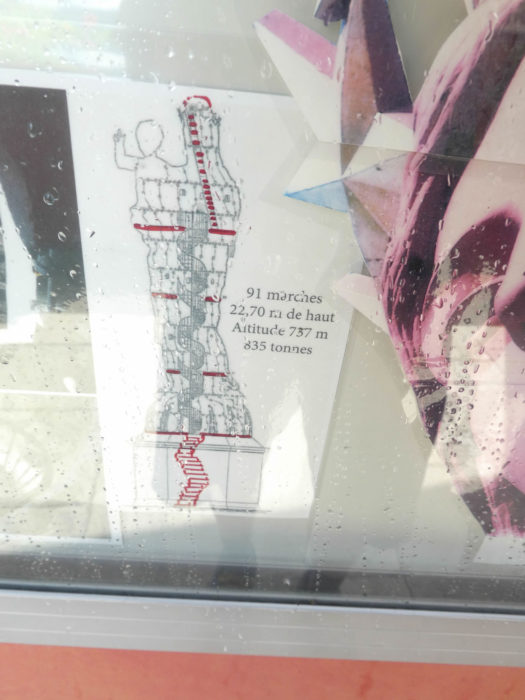 |
|
It was a Jesuit who had the idea to erect a statue of the Blessed Virgin at the top of the rock Corneille. Later, in 1853, a European competition was launched to choose the model of the statue and a subscription. More than 50 models were proposed and exhibited in the city. The jury decided on Jean-Marie Bonnassieux’s project. The narrow and paved route climbs sharply along the rock. Quickly, beautiful perspectives open on the cathedral, which you see better now the complexity of the building, with its church, its dome, its cloister, its steeple and the annex buildings. |
|
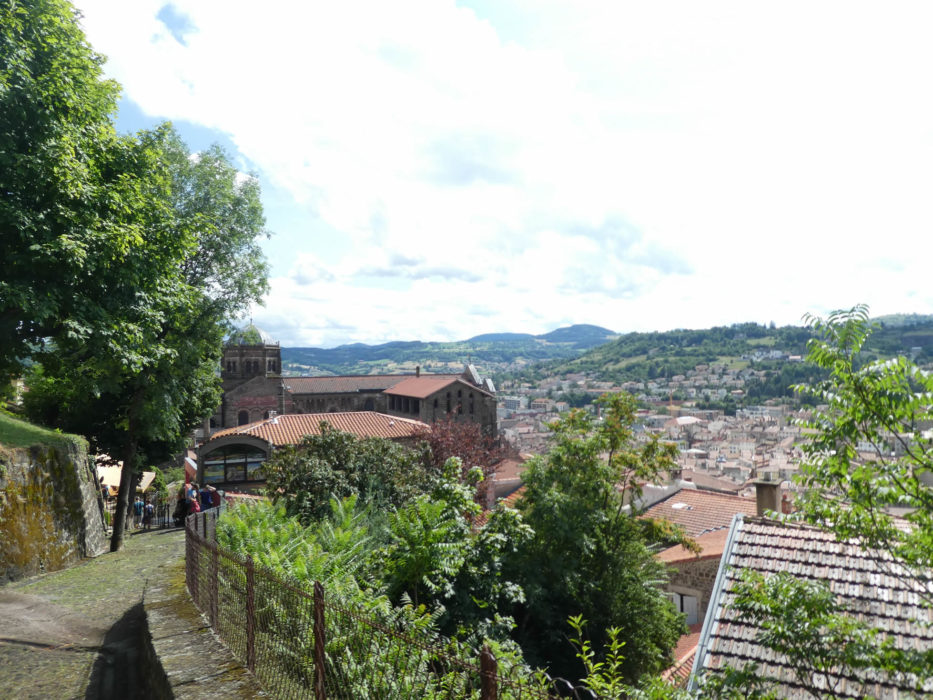 |
 |
|
Along the steep climb of stairs, the small crosses of a stylized Via Crucis are riveted to the basalt of the rock. |
|
 |
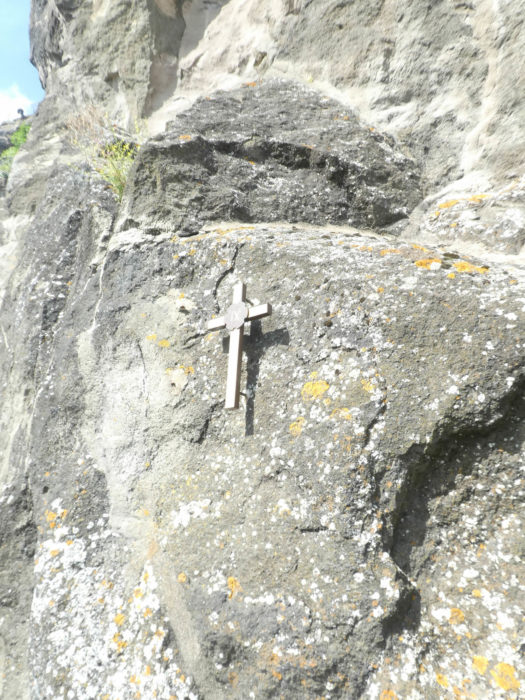 |
|
It’s tougher here than on the Santiago Track. There are many tourists who take breaks while climbing. The city hall is 628 meters above sea level, the statue 737 meters. Yet turn cornering, the statue grows. |
|
 |
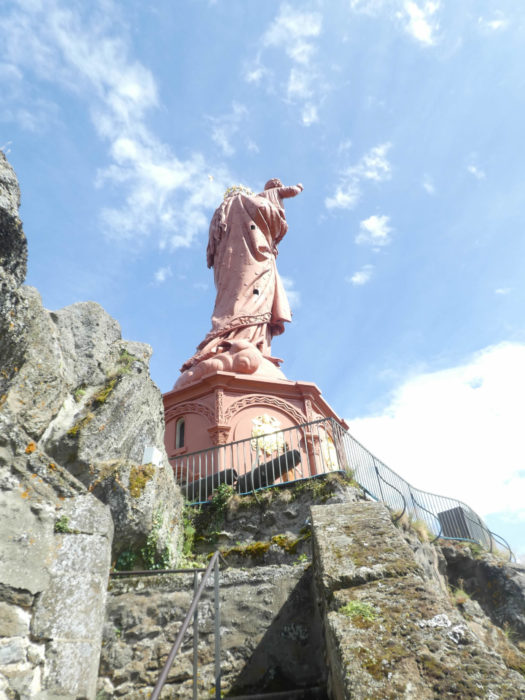 |
The first stone was laid in 1854. Then came the problems, the lack of money, equipment. So, the builders went to plead the case with Napoleon III, who allocated a sum of money, and especially the possibility of providing cast iron for the statue. The emperor assured to supply guns, if they could capture them at the seat of Sevastopol, in course at that time. Sevastopol fell, and the Russian naval guns took the road to France. The cannons were melted near Lyon, and the statue, in detached pieces, riveted, was assembled little by little in Puy. The statue was completed and blessed in 1860. It was the largest statue in the world before being dethroned a few years later by the Statue of Liberty.
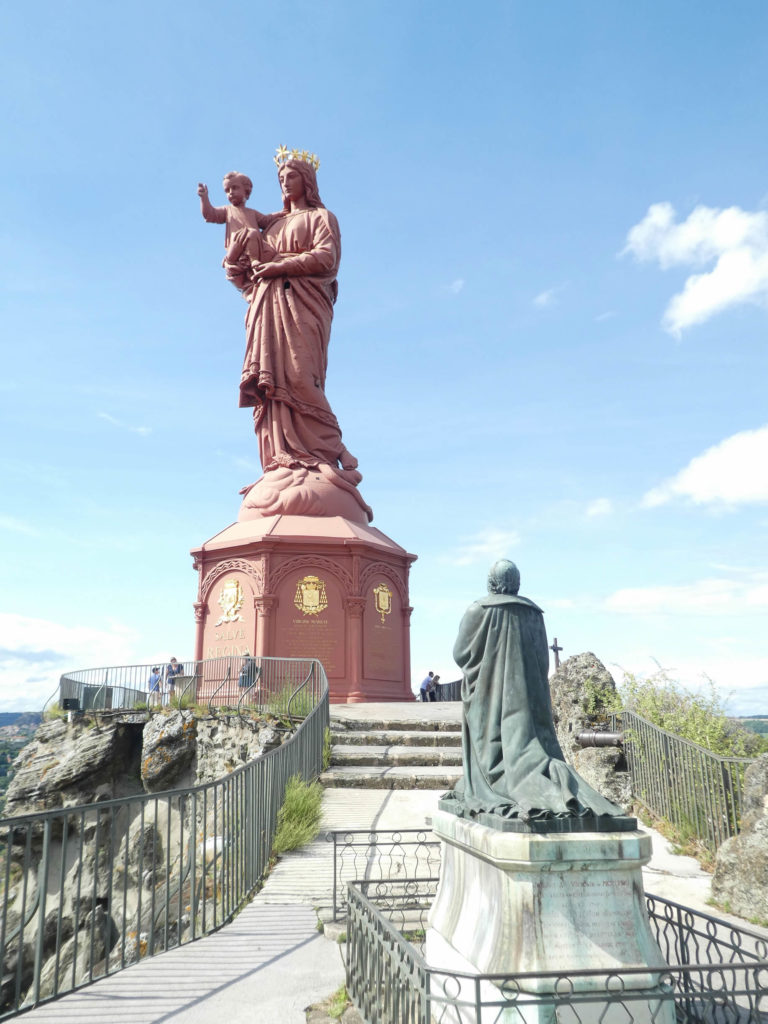
|
On its pedestal of red sandstone, as high as the statue, the statue itself measures 16 meters in height, for a weight of 110 tons. The head of the infant Jesus, with a circumference of 5 meters, weighs a ton anyway. A stone staircase consisting of 33 steps is arranged in the pedestal and provides access to the interior of the hollow statue by a winding staircase. If you are not claustrophobic, go for it. But, it’s like climbing 5 floors, and sometimes it stuck! Fortunately, you have small skylights in the state to breathe and look at the landscape. |
|
 |
 |
|
But whether you are at the top or bottom of the statue, the view of the city is the same, whether on the cathedral or the rock of Aiguilhe, which looks very tiny seen from here. |
|
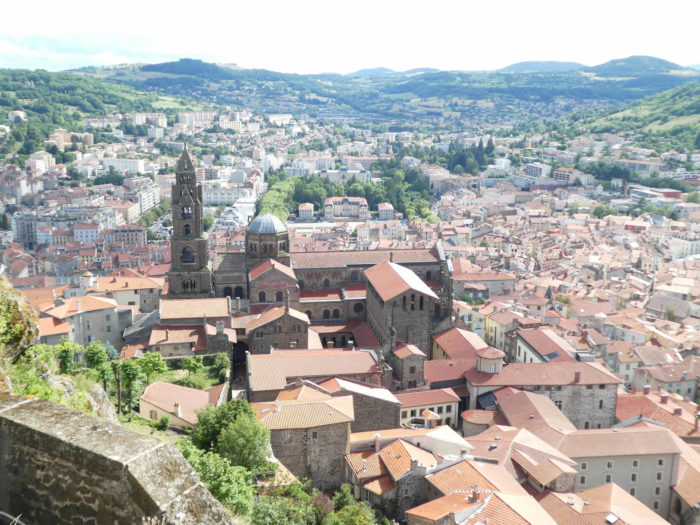 |
 |
|
Back near the cloister, the signposted circuit starts again along the walls towards the rock of Aiguilhe. It passes in front of the gigantic complex of the Hotel of the Department, where one does not have to be cramped in the administrations. |
|
 |
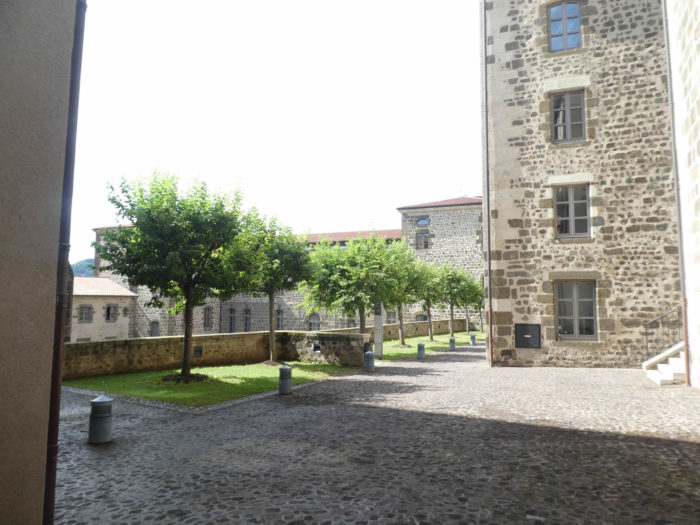 |
|
Then, through narrow little streets, you reach the rock. |
|
 |
 |
|
The chapel St Clair d’Aiguilhe is at the bottom of the volcanic peak on which stands the church of St Michel d’Aiguilhe. The chapel, also commonly called Temple of Diana, was built in the XIIth century. It was to be part of the Hospital of the poor St Nicolas d’Aiguilhe. |
|
 |
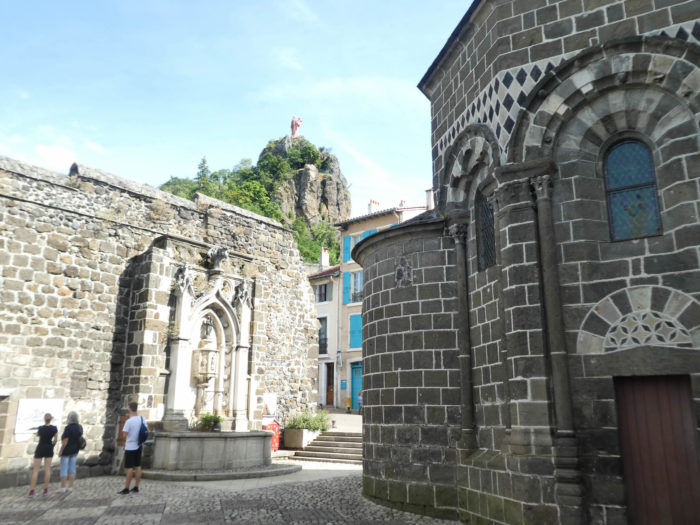 |
|
Here again, they are volcanic stones, mixed with arkose, sandstone, as for the cathedral. Slate roofs cover the roof. On the arches, the Byzantine influence is evident. The interior where harmony reigns is even more spiritual and beautiful than beautiful outside. In front of the chapel is the square of the Magic Square, with a fountain. |
|
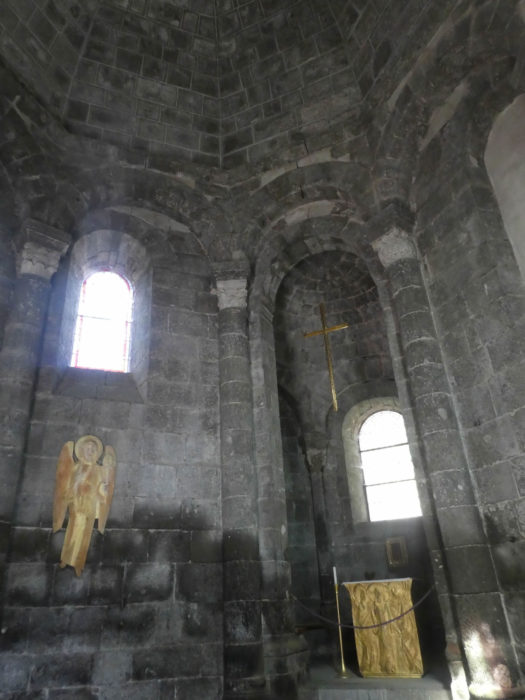 |
 |
|
During repairs to the Saint-Michel chapel in the last century, a plaster square was found under the embrasure of a window, where two readable words, rotas and opera remained. These two words, may be you already knew them. They are part of a magic square, the Sator square. This square has been reproduced in the square near the chapel. |
|
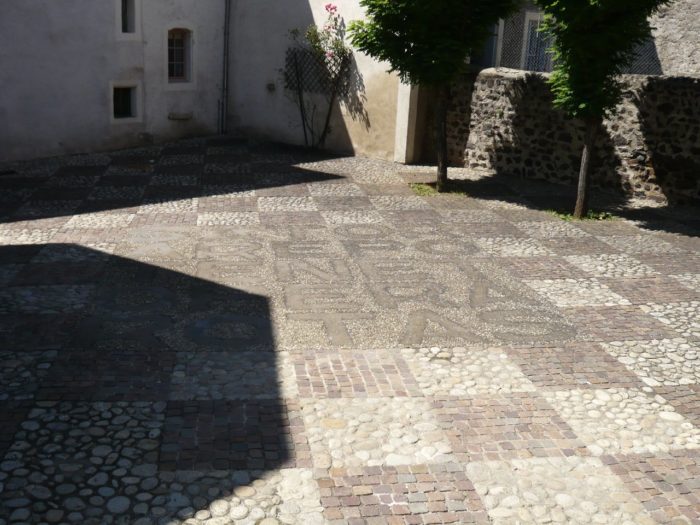 |
 |
| http://www.bibleetnombres.online.fr/sator.htm | https://code.energy/finding-magic-word-squares/ |
Magic squares have been found in different sites around the world, the first in Pompeii. They are composed of five five-letter words (sator, rotas, tenet, opera, arepo) whose characteristic is to be able to read each one four times in different directions, from bottom to top or from left to right. What do these words mean in Latin? SATOR is the sower, TENET is holding, OPERA is the work, ROTAS is the rotation of the wheel, but also the cycle of seasons, AREPO is not a Latin word, but could be Aramaic and mean sickle or harvest.
Some experts have interpreted this message which could say “The sower who plows and reaps the cycle of the seasons is the work (of God)”. Some then interpreted the square as a sign of recognition used by early Christians to recognize each other in secret and avoid possible repression. For, on the basis of the letters of the square, we can draw the anagram, which arranged in a cross twice gives Pater noster, to which we add twice the letters A and O, the latter being able to represent “the Alpha and the Omega” quoted in the apocalypse of St. John.
But in this secret world of esotericism, there are obviously other interpretations, some Jewish, others even Eastern. There are also mathematical magic squares, which some have introduced into religious symbolism. Today, we can play with the computer to reveal meanings even using the English language. It remains a total and clever mystery who will one day decipher the code. It’s up to you to rack your brains, as in the Da Vinci code.

|
But that the resolution of this enigma does not prevent you from climbing on the rock of St Michel d’Aiguilhe. Here, you have to pay the entrance to suffer in the climb. At first, there is a beautiful 3D slide show and some didactic rooms, where you can see the tiny basalt rock that is today the rock compared to the volcano of departure. |
|
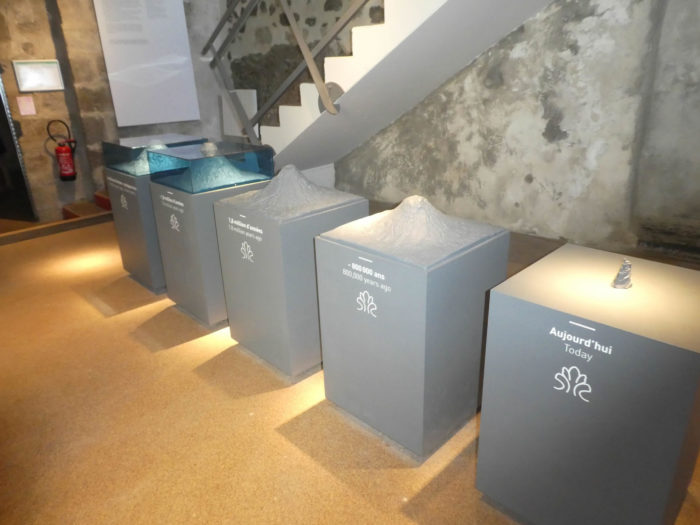 |
 |
|
You will not doubt the same vision of smallness by climbing on the flanks of the rock. The rock of Aiguilhe, it is 82 meters of height, by a staircase of 268 steps. |
|
 |
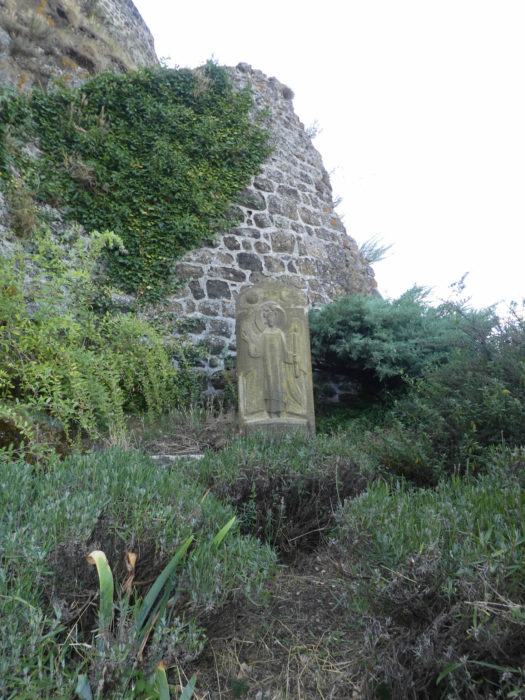 |
|
A first chapel was erected here in the Xth century. It is said that the pilgrims did not climb there, but many kings went up there. It is also said that hermits found refuge on the flanks of the rock. Then, a real chapel was built in the XIIth century, in front of the influx of pilgrims. Not being a parish, it was abandoned to the Revolution, its existence then threatened. It was saved from oblivion by Prosper Mérimée and others who entrusted the building to the state, giving it the status of a protected historical monument in 1840. Since then, several restorations were added in the chapel. The climb is not dangerous, but for people suffering from vertigo, the journey is difficult as uphill as downhill. |
|
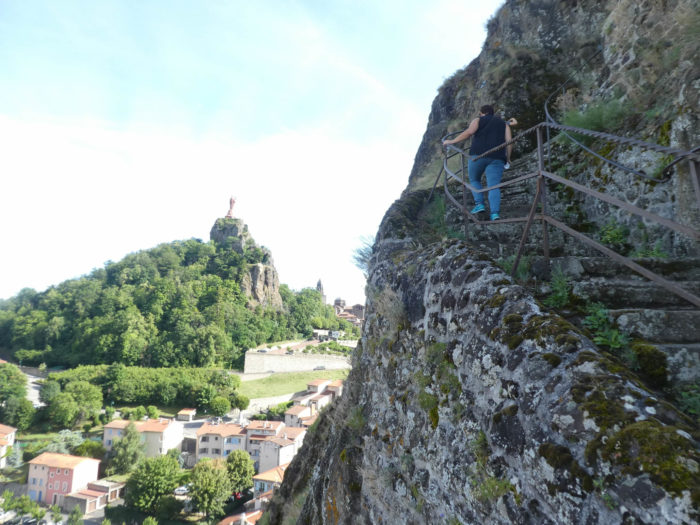 |
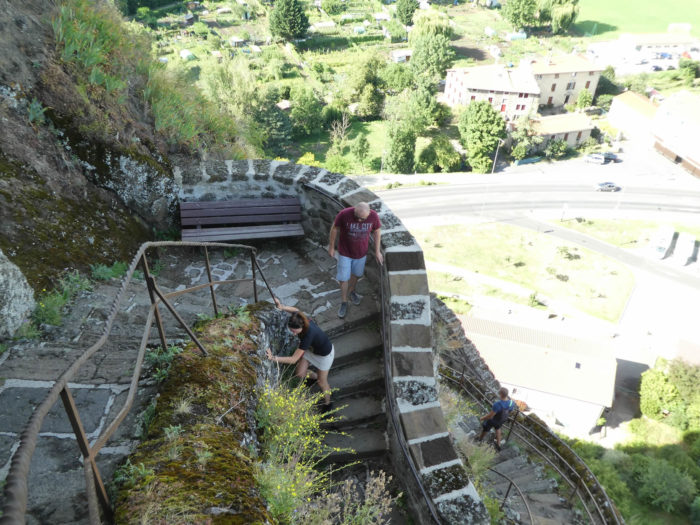 |
|
Here again, it is more difficult than the Way of Compostela to get to the end of the rock. |
|
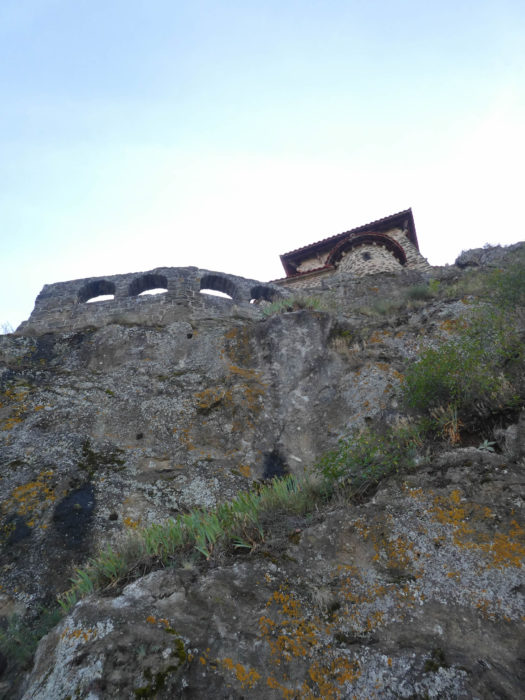 |
 |
|
At the top, there is a walk that goes around the building. |
|
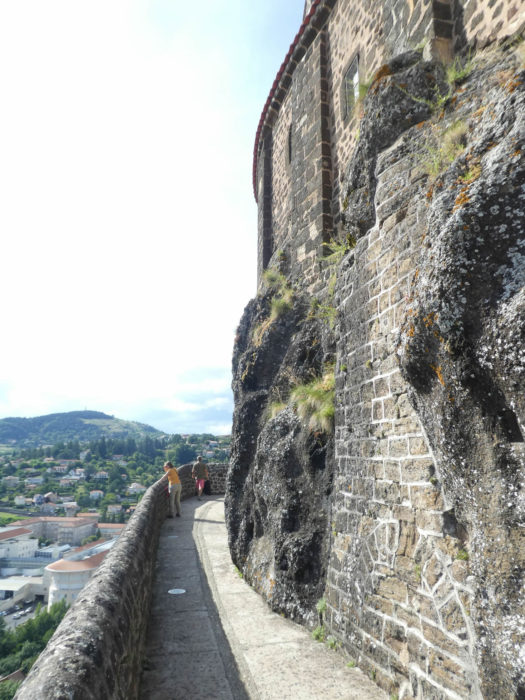 |
 |
|
The facade of the chapel, carved, polychrome, is magnificent. The door is framed by two columns with capitals carved with acanthus leaves, surmounted by a tympanum and trefoil arches and mosaics. Here, too, one tends to believe oneself in a Muslim country, as everywhere in Le Puy, whereas this style, in fact, is earlier than that of the Muslims. In architecture, you never know who copy. |
|
 |
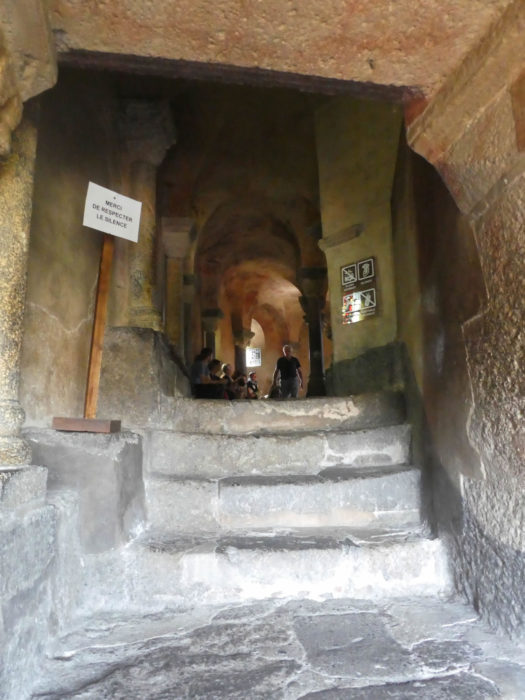 |
The interior of the chapel is of a great beauty. The atmosphere vibrates under Romanesque capitals and murals. Photos with flash are prohibited, we reproduce here a striking image of the place borrowed from the Internet.

Auteur :Torsade de Pointes, Wikimedia Commons
|
From there, the view is magnificent on the Rocher de Corneille, a little higher than the Rocher d’Aiguilhe. As you descend, you will discover the recent oratory dedicated to the Archangel Gabriel, where the Bishop of Le Puy erected the first oratory of San Gabriel in the XVth century. |
|
 |
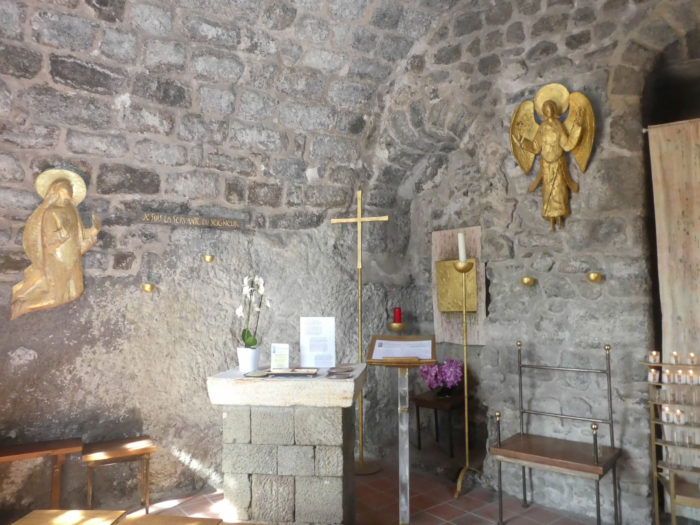 |
|
The city of Puy-en-Velay has 20’000 inhabitants, the urban area comprising 75’000 inhabitants. The old town, wedged inside a large circular boulevard where the flow of traffic flows, is made of small cobbled streets, with many restaurants, many shops, whose jewel remains the lace. There are also some very busy places. |
|
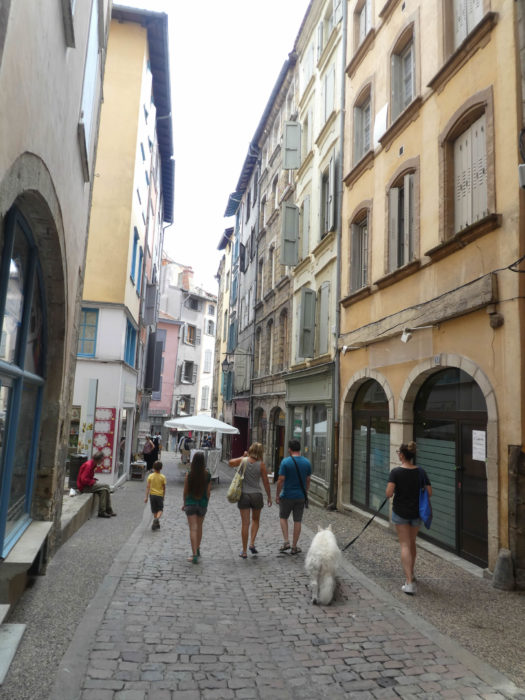 |
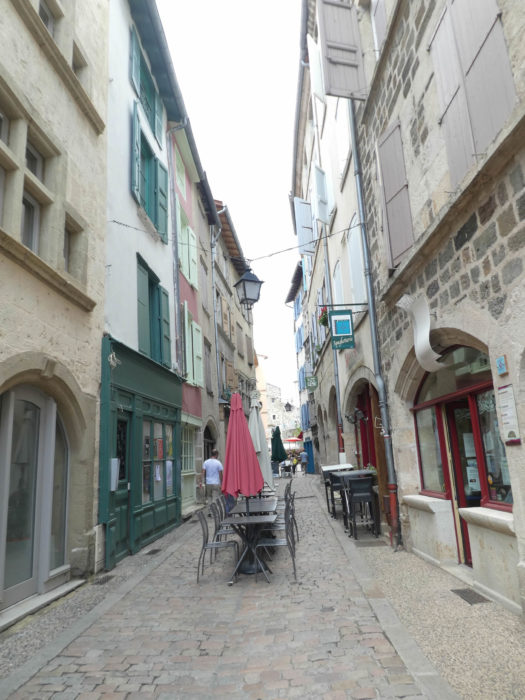 |
 |
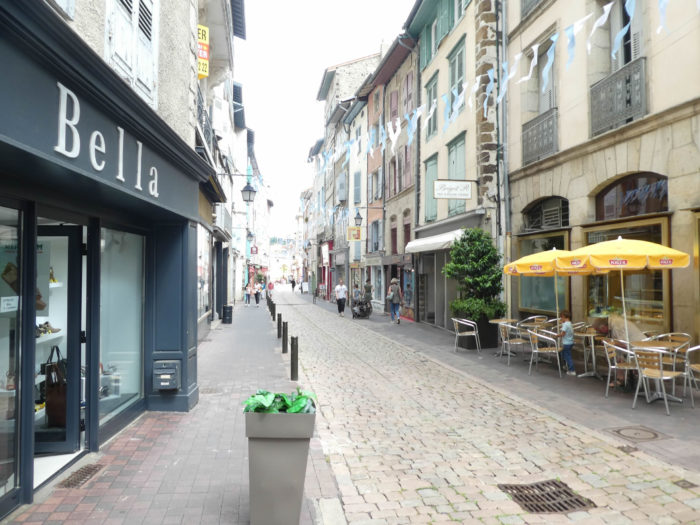 |
 |
Back to menu |
